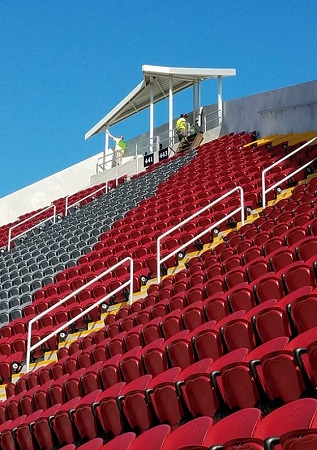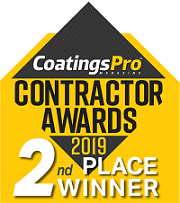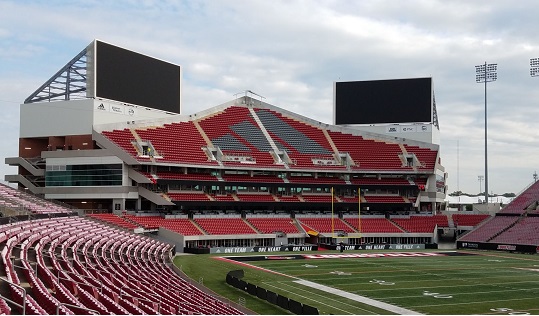Built in 1998, Cardinal Stadium — the outdoor home of the football team at the University of Louisville (UofL) — was recently expanded to accommodate 6,000 new seats in the north end zone. The 25,000-square-foot (2,322.5 m2) expansion to both outdoor and indoor areas added new seating, as well as a five-story common area complete with restrooms, concession stands, and corporate suites.
Renovations were also made to the nearby Howard Schnellenberger Football Complex, named after the iconic UofL coach. In all, these two complexes in Kentucky took about 18 months to renovate at a cost of ~$55 million, but they couldn’t be considered complete until they were fully decked out in the school’s famous colors of cardinal red and black.
Game Plan
Fortunately, UofL already knew a local painting contractor they could trust to implement their plan. Headquartered in Louisville, Ky. — about a 20-minute drive from campus — Howell & Howell Contractors, Inc. had previously provided coatings for Cardinal Stadium as well as other university buildings such as Jim Patterson Stadium, the home field of the Cardinals’ baseball team. With a crew of between 15 and 20 members, Howell & Howell had to tackle the football project aggressively so that work could be finished before the first Cardinals home game of the 2018 season.
“We had to be done and gone by midnight on Friday [before the game],” said Mike Dudukovich, vice president of coating operations for Howell & Howell. “So there was a hard schedule with a completion date at the end of it — and yes, we were able to meet it.” To make the demanding deadline, crew members initially worked four days a week in eight-, 10-, and 12-hour shifts. And as the project progressed, they regularly worked 12-hour shifts, including on weekends.
For additional assistance, Howell & Howell brought in four painting apprentices. “We’ve used this technique successfully in the past,” explained Dudukovich. “We bring them in between 30 to 60 minutes early, and they stay 30 to 60 minutes later. That way, when a journeyman comes in, all the work pots are there, all the paint is poured out, they’ve got their brushes and rollers, so they can just pick them up, and in five minutes they’re putting on paint. The overtime paid to the apprentices was money well spent.”
Closing Off the End Zone
A few years back, UofL officials decided that the horseshoe-like configuration of Cardinal Stadium — closed off at the south end zone, as well as the east and west sides — needed to be changed. By 2018, the north end zone was closed off to add more seats and fan-friendly features such as large, open common areas for pre- and post-game socializing.
 The new substrates used on the north end zone expansion included drywall, corrugated metal, concrete block, and cast-in-place concrete. Existing substrates were met at tie-in locations. As construction crews completed each area, the Howell & Howell crew moved in to supply the requisite coatings. “We’re like the tail wagging the dog — we’re always at the end,” joked Dudukovich.
The new substrates used on the north end zone expansion included drywall, corrugated metal, concrete block, and cast-in-place concrete. Existing substrates were met at tie-in locations. As construction crews completed each area, the Howell & Howell crew moved in to supply the requisite coatings. “We’re like the tail wagging the dog — we’re always at the end,” joked Dudukovich.
In terms of surface prep, the crew initially used a pole sander to make minor spot repairs, as needed. From there, Clemco blast pots with Schmidt valves helped them achieve a surface profile of between 1.5 to 2.5 mils (38.1–50.8 microns) throughout the two complexes. This enabled the crew to meet the NACE No. 3/Society for Protective Coatings (SSPC) Surface Preparation (SP) 6/ standard for a commercial blast cleaning.
UofL supplied the crew with Benjamin Moore coatings because, according to Dudukovich, the university has a deal to use their products. Graco airless paint sprayers were used to paint larger areas, while Purdy brushes and Bestt Liebco rollers were employed for cutting in and backrolling. Each non-metal surface received three coats: a primer epoxy coat at an average of 1.5 mils (38.1 microns), an intermediate epoxy coat at 5 to 8 mils (127.0–203.2 microns), and a urethane topcoat at 2 to 3 mils (50.8–76.2 microns). Dudukovich estimated that drying times for each coat required about 24 hours.
“By allowing other trades and crafts to complete their work and move into other areas, we were able to spray apply the coatings in lieu of brushing and rolling,” Dudukovich explained. This allowed the large Howell & Howell crew to apply their coatings as efficiently as possible, all while avoiding congestion from other trades.
One of the notable additions to the expanded north end zone was what Dudukovich referred to as the “spine,” or structural steel support beam for the newly installed seats. This 60- to 65-foot-tall (18.2–19.8 m) structure was coated with a zinc epoxy urethane finish system, as were other newly built metal surfaces. Another new addition to the common areas were “clouds” of different sizes and shapes that hung suspended over an exposed ceiling that was painted flat black, which created a startling visual effect. “When the light shone down, it made the ceiling disappear, so all you saw was these white clouds floating above your head,” Dudukovich recalled.
In coating these elevated surfaces, the crew observed proper safety protocols. “Anything over 4 feet [1.2 m] had to be 100 percent tied off, with 100 percent fall protection,” Dudukovich said. The crew also wore Bullard hard hats and safety glasses, high-visibility safety vests, and 3M respirator masks with organic charcoal filters as personal protective equipment (PPE). “The whole project was completely accident free — we didn’t even put a band-aid on anybody,” he recalled. “Our people did a tremendous job in being safe.”
Working Swift-ly
As crews worked on the north end zone complex, renovations were made simultaneously to the Howard Schnellenberger Football Complex located underneath the north end zone seating area. Cardinal football players saw their weight room and conditioning center double in size, and they enjoyed additional amenities such as upgraded rehabilitation facilities and expanded theaters, where they could watch game film. Coaches and trainers received refurbished offices on the second floor of the complex.
Because construction had closed off thousands of parking spots around the stadium, the university came up with other measures, such as creating an ancillary parking lot, to ease congestion. The expansion project also temporarily displaced some personnel. “The staff on site, the coaches, and even the college president moved to their old offices across the street until this was built,” noted Dudukovich. “They moved in about a month early, so their [new] offices had to be done a month prior to the first game.” When they returned to the Schnellenberger complex, they would have noticed, among other things, that the hollow metal doors to their new offices were coated with grey-colored Benjamin Moore industrial enamel paints.
Dudukovich said that the crew was able to complete its work with “minimal invasion” of staff privacy. There was only one thing able to halt progress on the project, albeit temporarily: Taylor Swift. The pop-music superstar performed at the multi-use Cardinal Stadium in June 2018.
“We had to stop for four days, but she gave out free tickets for the workers. So they didn’t complain too much,” Dudukovich said.

Coatings Touchdown
Dudukovich had nothing but praise for the “good, pleasant atmosphere” at UofL. The feedback he received for his crew’swork was similarly positive: “The president of the university, the coaches and players, came through and they all just loved it. They couldn’t say enough about how nice it looked compared to their old facilities — it was top notch.” In fact, it was “top notch” enough to win second place in the Specialty Projects category in CoatingsPro’s 2019 Contractor Awards Program.
Dudukovich was a daily presence at both work sites and oversaw the project from its start in April 2017 to its completion in October 2018. Given the tight schedule, he was proud of his crew’s commitment to excellence. “I’d come by and tell them, it’s easy for me to come by and pick out what you’re doing, but I want to tell you you’re doing this right.”
